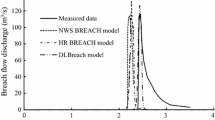Abstract
A computer model has been developed for simulation of breach erosion of earthfill dams (BEED). The model incorporates the processes of surface erosion and slope sloughing to simulate breach enlargement. Depletion of reservoir water is approximated by a volume continuity equation while broad-crested weir hydraulics is utilized to describe flow over and through the breach. Due to the implicit form of these equations, an iterative solution is proposed with convergence achieved within only a few iterations. The BEED model is written in both FORTRAN 77 and BASIC computer languages. Testing of the model using historical data of the failures of Teton and Huaccoto dams showed that timing, shape, and magnitude of the predicted outflow hydrograph were adequately simulated by this model. The same is true for the dimensions of the terminal breach. A sensitivity analysis indicated that internal friction angle and the relation for surface erosion were the major factors affecting the model results.
Similar content being viewed by others
References
Brater, E.: 1959, in L. C. Urquhart (ed.), Hydraulics, Civil Engineering Handbook, Section 4, McGraw-Hill, New York.
Brown, R. J. and Rogers, D. C.: 1977, A simulation of the hydraulic events during and following the Teton Dam failure, Proceedings of Dam-Break Flood Routing Model Workshop, Bethesda, Maryland, 18–20 October, pp. 131–163.
Chugaev, R. R.: 1964, Stability Analysis of Earth Slopes, Israel Program for Scientific Translations, Jerusalem.
Corps of Engineers, U.S. Army, 1975. National Program of Inspection of Dams, Department of the Army, Office of the Chief of Engineers, Washington, DC.
Cristofano, E. A.: 1965, Method of Computing Rate of Failure of Earth Fill Dams, Bureau of Reclamation, Denver, Colorado.
Fread, D. L.: 1977, The development and testing of a dam-break flood forecasting model, Proceedings of Dam-Break Flood Routing Model Workshop, Bethesda, Maryland, 18–20 October, pp. 164–197.
Fread, D. L.: 1984, A breach erosion model for earthen dams, NWS Report, NOAA, Silver Spring, MD.
Gruner, E.: 1967, The mechanism of dam failure, Neuvième Congrès des Grands Barrages, CIGB, Q. 34, R. 12, Istanbul, pp. 197–206.
Jansen, R. B.: 1980, Dam and Public Safety, Water and Power Resources Service, United States Government Printing Office, Denver, Colorado.
MacDonald, T. C. and Langridge-Monopolis, J.: 1984, Breaching characteristics of dam failures, J. Hydraulic Eng. ASCE 110, 567–586.
Ponce, V. M. and Yevjevich, V.: 1978, Muskingum-Cunge method with variable parameters, J. Hydraulics Div. ASCE 104, [HY12], 1663–1667.
Ponce, V. M. and Tsivoglou, A. J.: 1981, Modeling gradual dam breaches. J. Hydraulics Div. ASCE 107, [HY7] (Proc. Paper 16372), 829–838.
Ponce, V. M.: 1982, Documented cases of earth dam breaches, San Diego State University Series No. 82149, San Diego, CA.
Prasad, R., 1970. Numerical method of computing flow profiles. J. Hydraulics Div. ASCE 96, [HY1], 75–85.
Pugh, C. A. and Gray, F. W. Jr.: 1984, Fuse plug embankments in auxiliary spillways-developing design guidelines and parameters, Bureau of Reclamation Report, Denver, CO.
Scarlatos, P. D. and Singh, V. P.: 1986, Mud flow and sedimentation problems associated with a dam-break event, in S. Y. Wang et al. (eds.), River Sedimentation, The University of Mississippi, MS, pp. 1063–1068.
Simons, D. B. and Senturk, F.: 1976, Sediment Transport Technology, Water Resources Publications, Fort Collins, CO.
Singh, K. P. and Snorrason, A.: 1982, Sensitivity of outflow peaks and flood stages to the selection of dam breach parameters and simulation models, State Water Survey Division Report 289, Surface Water Section at the University of Illinois.
Singh, V. P. and Scarlatos, P. D.: 1985a, Modeling of gradual earth fill dam erosion, Proc. Symposium on Speciality Sessions of Environmental Geotechnics and Problematic Soils, AIT, Bangkok, Thailand, December 2–12.
Singh, V. P. and Scarlatos, P. D.: 1985b, Breach erosion of earth-fill dams and flood routing: BEED Model, Military Hydrology Report, pp. 131, U.S. Army Engineer Waterways Experiment Station, Environmental Laboratory, Vicksburg, Mississippi.
Singh, V. P., Scarlatos, P. D., Jourdan, M. R., and Collins, J. G.: 1986, Simulation aspects of earth dam failures. In G. A. Keramides and Brebbia (eds.), Computational Methods and Experimental Measurements, Springer-Verlag, New York, pp. 263–273.
Author information
Authors and Affiliations
Rights and permissions
About this article
Cite this article
Singh, V.P., Scarlatos, P.D., Collins, J.G. et al. Breach erosion of earthfill dams (BEED) model. Nat Hazards 1, 161–180 (1988). https://doi.org/10.1007/BF00126613
Received:
Revised:
Issue Date:
DOI: https://doi.org/10.1007/BF00126613




